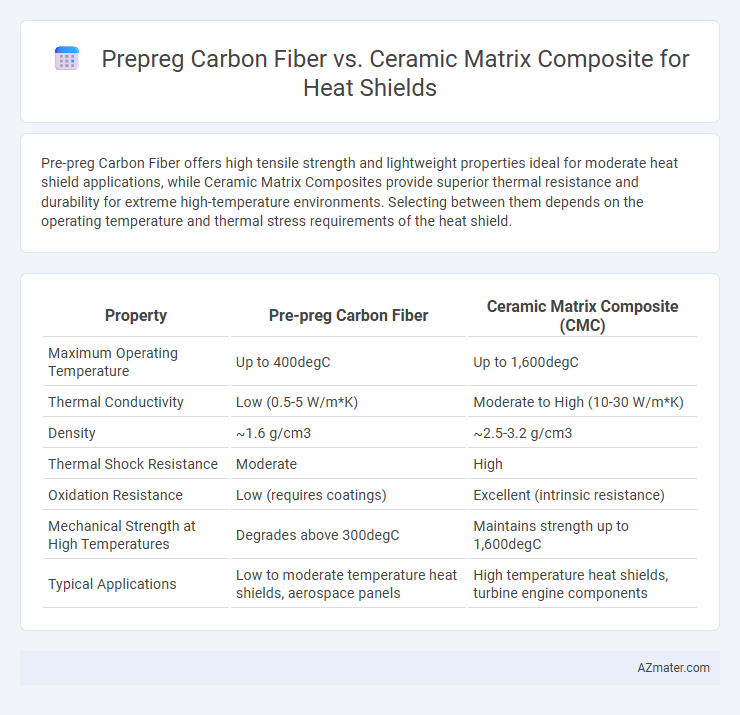Pre-preg Carbon Fiber offers high tensile strength and lightweight properties ideal for moderate heat shield applications, while Ceramic Matrix Composites provide superior thermal resistance and durability for extreme high-temperature environments. Selecting between them depends on the operating temperature and thermal stress requirements of the heat shield.
Table of Comparison
| Property | Pre-preg Carbon Fiber | Ceramic Matrix Composite (CMC) |
|---|---|---|
| Maximum Operating Temperature | Up to 400degC | Up to 1,600degC |
| Thermal Conductivity | Low (0.5-5 W/m*K) | Moderate to High (10-30 W/m*K) |
| Density | ~1.6 g/cm3 | ~2.5-3.2 g/cm3 |
| Thermal Shock Resistance | Moderate | High |
| Oxidation Resistance | Low (requires coatings) | Excellent (intrinsic resistance) |
| Mechanical Strength at High Temperatures | Degrades above 300degC | Maintains strength up to 1,600degC |
| Typical Applications | Low to moderate temperature heat shields, aerospace panels | High temperature heat shields, turbine engine components |
Introduction to Advanced Heat Shield Materials
Pre-preg carbon fiber and ceramic matrix composites (CMCs) serve as critical materials in advanced heat shield applications due to their exceptional thermal resistance and structural integrity. Pre-preg carbon fiber offers high strength-to-weight ratios and excellent thermal conductivity, making it ideal for moderate heat environments. Ceramic matrix composites provide superior oxidation resistance and can withstand extreme temperatures above 1,200degC, making them suitable for the most demanding aerospace and industrial heat shield requirements.
What is Pre-preg Carbon Fiber?
Pre-preg carbon fiber is a composite material consisting of carbon fibers pre-impregnated with a resin matrix, typically epoxy, which is partially cured to a tacky state for ease of handling and molding. This material offers superior strength-to-weight ratio and excellent thermal resistance, making it ideal for aerospace and automotive heat shield applications where precision and durability under high temperatures are critical. Compared to ceramic matrix composites, pre-preg carbon fiber provides better impact resistance and manufacturability but typically operates at lower maximum temperatures.
Understanding Ceramic Matrix Composites (CMC)
Ceramic Matrix Composites (CMCs) offer superior thermal stability and oxidation resistance compared to pre-preg carbon fiber, making them ideal for high-temperature heat shield applications in aerospace. CMCs consist of ceramic fibers embedded in a ceramic matrix, providing enhanced fracture toughness and durability at temperatures exceeding 1,200degC. Their ability to maintain structural integrity under extreme thermal stress outperforms the carbon fiber composites that typically degrade above 600degC.
Thermal Resistance: Pre-preg Carbon Fiber vs CMC
Pre-preg carbon fiber heat shields exhibit excellent thermal resistance up to temperatures of approximately 400degC, providing effective insulation in moderate heat environments. Ceramic Matrix Composites (CMC) significantly outperform pre-preg carbon fiber, maintaining structural integrity and thermal stability above 1200degC, making them ideal for extreme thermal applications such as hypersonic vehicles and re-entry spacecraft. The superior oxidation resistance and low thermal conductivity of CMCs enable enhanced thermal management compared to pre-preg carbon fiber composites.
Weight and Density Comparison
Pre-preg carbon fiber composites typically exhibit lower density values around 1.5-1.6 g/cm3, providing lightweight structural benefits essential for aerospace heat shields. Ceramic matrix composites (CMCs), however, possess higher densities ranging from 2.5 to 3.2 g/cm3 but offer superior thermal stability and oxidation resistance at elevated temperatures exceeding 1200degC. The weight advantage of pre-preg carbon fiber enhances fuel efficiency and payload capacity, while CMCs ensure enhanced durability under extreme thermal stress despite the increased mass.
Durability and Mechanical Strength
Pre-preg carbon fiber exhibits high tensile strength and excellent fatigue resistance, making it a durable option for heat shield applications subjected to cyclic mechanical loads. Ceramic matrix composites (CMCs) offer superior thermal stability and exceptional resistance to high-temperature oxidation, maintaining mechanical integrity in extreme heat environments. The choice between pre-preg carbon fiber and CMCs hinges on the specific thermal and mechanical requirements, with CMCs outperforming in thermal durability while carbon fiber excels in mechanical strength under lower temperature thresholds.
Manufacturing Process and Cost Analysis
Pre-preg carbon fiber heat shields benefit from established autoclave curing processes that offer high precision and repeatability but involve significant capital investment and longer cycle times, leading to higher manufacturing costs. Ceramic matrix composites (CMCs) require complex chemical vapor infiltration or slurry impregnation techniques with subsequent high-temperature sintering, resulting in more intricate, energy-intensive processes that escalate production expenses. Cost analysis shows pre-preg carbon fiber is generally more economical for moderate heat resistance applications, while CMCs, despite their steep manufacturing costs, provide superior thermal performance and durability in extreme environments.
Applications in Aerospace and Automotive Industries
Pre-preg carbon fiber offers superior tensile strength and lightweight properties, making it ideal for aerospace heat shields that require high impact resistance and thermal stability during re-entry. Ceramic matrix composites (CMCs) provide exceptional high-temperature tolerance and oxidation resistance, enhancing the durability of automotive exhaust components and turbine engine heat shields. In aerospace, CMCs enable weight reduction and improved thermal protection in jet engines, while pre-preg carbon fiber is favored for structural heat shields where flexibility and damage tolerance are critical.
Environmental and Longevity Considerations
Pre-preg carbon fiber heat shields offer excellent thermal protection but are susceptible to environmental degradation such as moisture absorption and UV exposure, potentially reducing lifespan. Ceramic matrix composites (CMC) provide superior high-temperature stability and oxidation resistance, enhancing durability in extreme conditions while minimizing environmental impact during operational life. Longevity of CMC heat shields surpasses that of carbon fiber in aerospace and automotive applications due to their resilience against thermal cycling and harsh atmospheric elements.
Choosing the Right Material for Heat Shield Solutions
Pre-preg carbon fiber offers exceptional strength-to-weight ratio and thermal conductivity ideal for moderate heat shield applications, while ceramic matrix composites (CMCs) provide superior heat resistance, withstanding temperatures above 1200degC, making them suitable for extreme thermal environments. Material selection depends on the operating temperature, durability requirements, and weight constraints; CMCs excel in aerospace and high-temperature industrial uses where thermal stability and oxidation resistance are critical. Evaluating mechanical performance, thermal resistance, and cost-effectiveness ensures optimal heat shield solutions tailored to specific mission profiles or industrial applications.

Infographic: Pre-preg Carbon Fiber vs Ceramic Matrix Composite for Heat Shield
 azmater.com
azmater.com